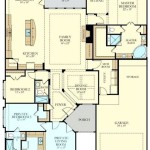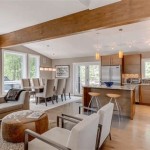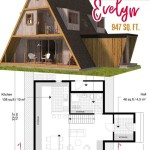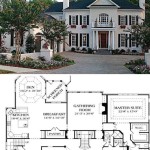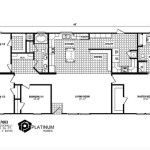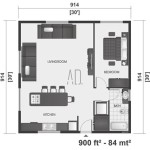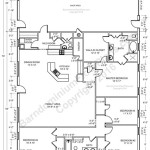House Plans With Screen Porch: Blending Indoor Comfort and Outdoor Living
The appeal of homes extends beyond the interior spaces. The integration of outdoor living areas has become a significant factor in home design, with screen porches emerging as a popular choice. House plans with screen porches offer a unique blend of indoor comfort and outdoor relaxation, allowing homeowners to enjoy the natural environment while being shielded from insects and the elements. These plans cater to individuals seeking a seamless transition between their home’s interior and the surrounding landscape, enhancing both the functionality and aesthetic value of the property. This article examines the various considerations involved in selecting house plans with screen porches, highlighting key design elements and benefits.
Understanding the Appeal of Screen Porches
Screen porches represent a compromise between fully enclosed spaces and open-air patios. They offer protection from mosquitoes, flies, and other insects, making outdoor gatherings more enjoyable. Furthermore, they provide shade from the sun and a buffer against light rain, extending the usability of the outdoor area throughout the year. The appeal of screen porches also stems from their versatility. They can serve as dining areas, relaxation zones, or even outdoor living rooms, depending on their size, design, and furnishings. This adaptability allows homeowners to tailor the space to their specific needs and preferences.
Historical precedents also contribute to the enduring popularity of screen porches. They evoke a sense of nostalgia, harking back to a time when outdoor living was more integral to daily life. Many older homes feature front or back porches that have been repurposed as screened-in areas. This connection to tradition, combined with modern design sensibilities, makes screen porches a timeless addition to any home.
The psychological benefits of spending time in nature are well-documented. Access to sunlight, fresh air, and green spaces can reduce stress, improve mood, and enhance overall well-being. Screen porches provide a convenient way to connect with nature without sacrificing comfort or protection. This connection to the outdoors can contribute to a healthier and more fulfilling lifestyle.
Key Considerations When Choosing House Plans With Screen Porches
Selecting house plans with screen porches requires careful consideration of several factors, including location, size, orientation, and design. The location of the screen porch within the overall house plan is crucial for its functionality and accessibility. Ideally, the porch should be located adjacent to living areas such as the kitchen or living room, facilitating easy access for entertaining and daily use. The size of the porch should be proportionate to the size of the house and the intended use of the space. A small porch may be suitable for a cozy seating area, while a larger porch can accommodate dining tables, lounge chairs, and even outdoor kitchens.
Orientation plays a significant role in the usability of the screen porch. In warmer climates, a north- or east-facing porch will provide shade during the hottest parts of the day, while a south- or west-facing porch may require additional shading solutions, such as awnings or pergolas. The design of the porch should complement the overall architectural style of the house. Whether it's a traditional farmhouse, a modern bungalow, or a contemporary residence, the screen porch should seamlessly integrate with the existing structure. Material choices, such as wood, composite decking, and screening, should be carefully selected to ensure durability, weather resistance, and aesthetic appeal.
Accessibility is another important consideration. The porch should be easily accessible from both the interior of the house and the surrounding outdoor areas. Wide doorways, ramps, or steps can improve accessibility for individuals with mobility challenges. In addition, the porch should be designed with adequate lighting and ventilation. Lighting fixtures can enhance the ambiance of the space and provide safety during nighttime use, while proper ventilation can help to keep the porch cool and comfortable, especially in humid climates.
Design Elements of Effective Screen Porches
The design of a screen porch should prioritize comfort, functionality, and aesthetic appeal. Several design elements can contribute to the overall success of the space. Flooring options include wood decking, composite decking, concrete pavers, and tile. Wood decking offers a natural and warm aesthetic, while composite decking is more durable and requires less maintenance. Concrete pavers and tile are versatile options that can be customized to match the style of the house. Screening materials vary in terms of mesh size, durability, and visibility. Aluminum screens are a popular choice due to their affordability and durability, while fiberglass screens offer better visibility and resistance to tearing. Pet-resistant screens are available for homeowners with pets.
Roofing options for screen porches include gable roofs, hip roofs, and shed roofs. Gable roofs provide good ventilation and allow for ample headroom, while hip roofs offer better protection from the wind and rain. Shed roofs are a simple and cost-effective option that can be used for smaller porches. Ceiling fans can help to circulate air and keep the porch cool, especially during the summer months. Outdoor lighting fixtures, such as sconces, pendant lights, and recessed lighting, can enhance the ambiance of the space and provide safety during nighttime use. Furniture choices for screen porches should be durable, weather resistant, and comfortable. Wicker furniture, teak furniture, and aluminum furniture are all popular options. Cushions and pillows should be made from outdoor fabrics that are resistant to fading, mildew, and water damage.
Integration with the surrounding landscape is crucial for creating a cohesive outdoor living space. Landscaping elements, such as plants, trees, and shrubs, can enhance the privacy and aesthetic appeal of the screen porch. Potted plants, hanging baskets, and window boxes can add color and texture to the space. A well-designed landscape can also help to buffer the porch from noise and wind, creating a more relaxing and comfortable environment. The incorporation of outdoor rugs can define the space and add warmth and texture to the floor. A well-chosen rug can tie together the various elements of the porch and create a cohesive design.
Maximizing the Functionality of a Screen Porch
To maximize the functionality of a screen porch, consider its intended use and design it accordingly. A screen porch can be used for a variety of purposes, including dining, relaxing, entertaining, and even working. If the primary use is dining, a large dining table and comfortable chairs are essential. An outdoor kitchen, complete with a grill, sink, and refrigerator, can further enhance the dining experience. If the porch is intended for relaxation, comfortable lounge chairs, a hammock, or a swing can create a cozy and inviting space.
For entertaining, consider adding a bar area with seating, a sound system, and a television. This can transform the porch into an outdoor entertainment zone. If the porch is intended for working, a comfortable desk, a chair, and adequate lighting are essential. A wi-fi extender can ensure a reliable internet connection. Storage solutions, such as benches with built-in storage, shelves, and cabinets, can help to keep the porch organized and clutter-free. These storage areas can be used to store cushions, pillows, blankets, and other outdoor accessories.
Seasonal considerations are important for maximizing the functionality of a screen porch. In the winter months, consider adding a portable heater or a fireplace to extend the use of the porch. Clear vinyl curtains can be used to enclose the porch and protect it from the wind and cold. In the summer months, consider adding a misting system or a shade sail to keep the porch cool. Mosquito netting can provide additional protection from insects. Regularly cleaning and maintaining the screen porch will help to keep it in good condition and extend its lifespan. Sweep or vacuum the floor regularly, clean the screens with a mild detergent, and inspect the roof and structure for any signs of damage.
The Cost of House Plans With Screen Porches
The cost of house plans with screen porches can vary widely depending on the size, design, and materials used. Simple screen porches can be relatively inexpensive to build, while more elaborate porches with custom features can be quite costly. Factors that affect the cost include the size of the porch, the type of roofing, the type of screening, the flooring materials, and the furniture and accessories. Hiring a professional architect or designer can add to the cost, but it can also ensure that the porch is well-designed and functional. A detailed budget should be created before starting the project. This budget should include all of the costs associated with the project, including materials, labor, permits, and fees.
Obtaining multiple bids from contractors is essential for finding the best price. Be sure to compare the bids carefully and ask questions about any discrepancies. Permits may be required for building a screen porch, especially if it is attached to the house. Check with the local building department to determine what permits are required. Homeowner's insurance may cover damage to a screen porch, but it is important to check with the insurance company to determine the extent of coverage. Financing options for building a screen porch include home equity loans, personal loans, and credit cards. Be sure to compare the interest rates and terms of the various financing options before making a decision.
Adding a screen porch can increase the value of a home, especially in areas where outdoor living is popular. A well-designed and functional screen porch can enhance the curb appeal of the home and make it more attractive to potential buyers. It can also provide a valuable outdoor living space that can be enjoyed by the entire family. However, it is important to consider the cost of the project and the potential return on investment before making a decision. Consult with a real estate professional to determine the potential impact on the value of the home.

Your Guide To House Plans With Screened In Porches Houseplans Blog Com

Your Guide To House Plans With Screened In Porches Houseplans Blog Com

Your Guide To House Plans With Screened In Porches Houseplans Blog Com

Your Guide To House Plans With Screened In Porches Houseplans Blog Com

Charming 2 Bed Cottage With Screened Porch 130030lls Architectural Designs House Plans

Your Guide To House Plans With Screened In Porches Houseplans Blog Com

Your Guide To House Plans With Screened In Porches Houseplans Blog Com

House Plans With Screened Porch Or Sunroom Drummond

Exclusive Craftsman House Plan With Screened Porch 149003and Architectural Designs Plans

Exclusive Modern Farmhouse Plan With Rear Screen Porch And Fireplace 130036lls Architectural Designs House Plans

